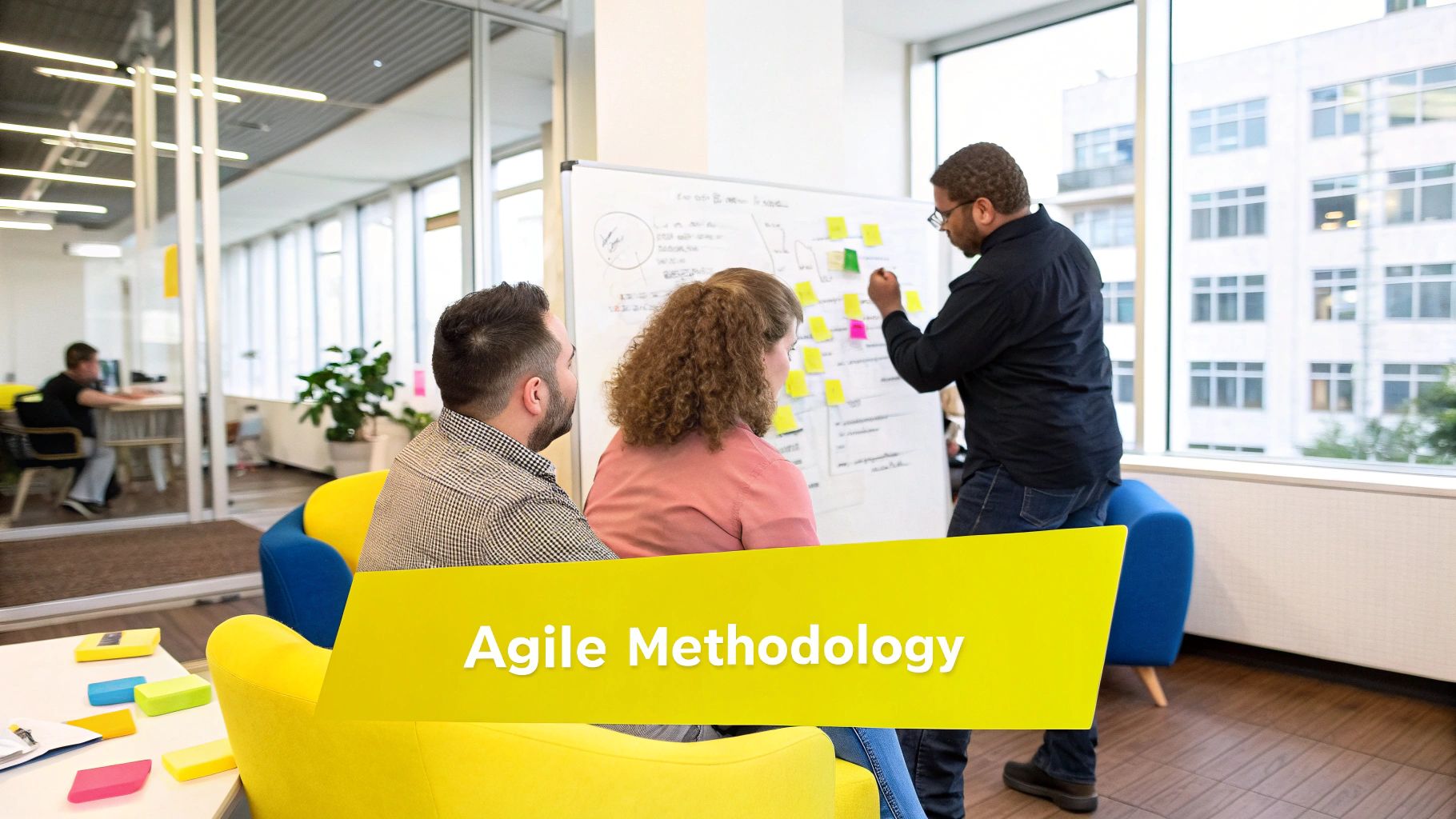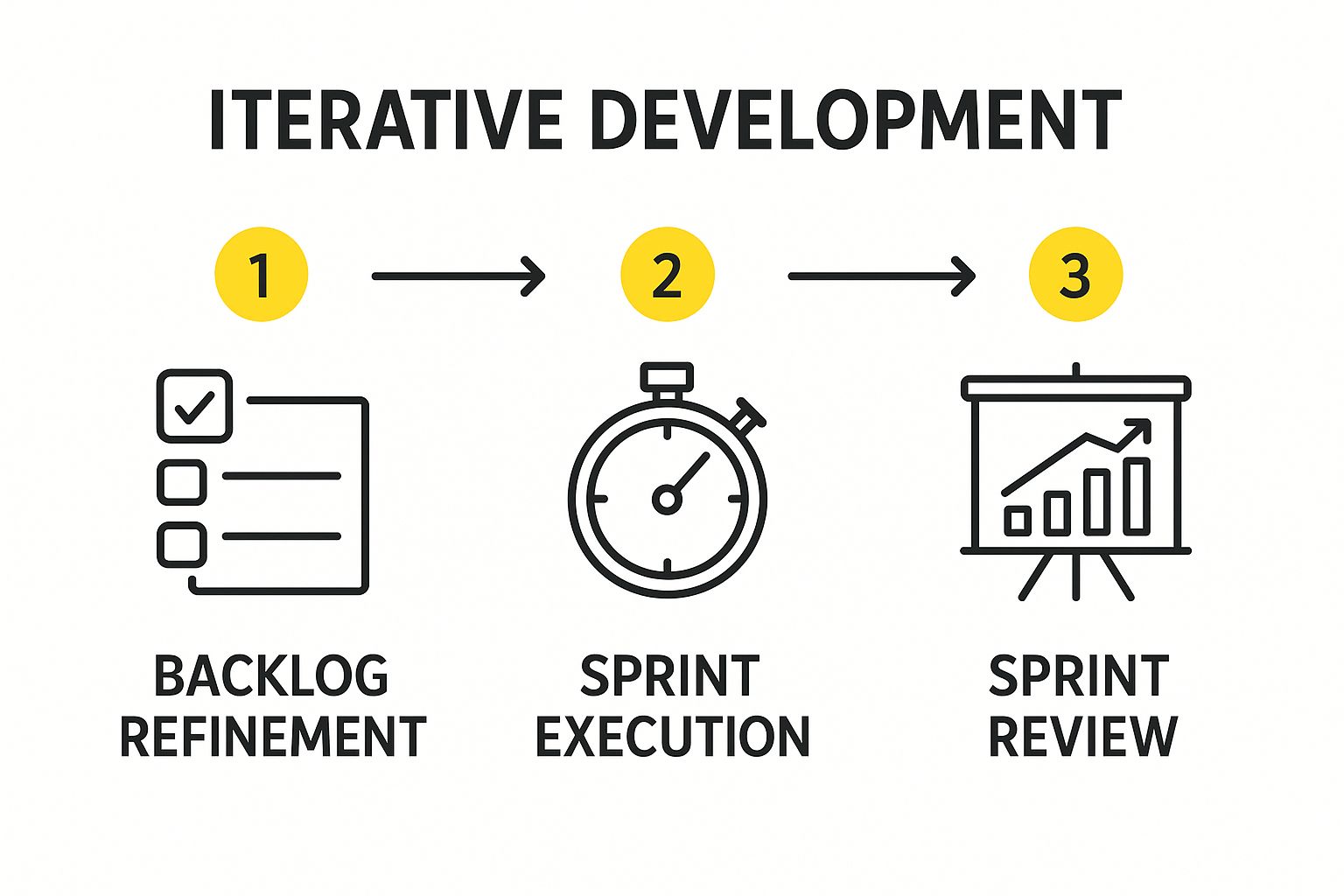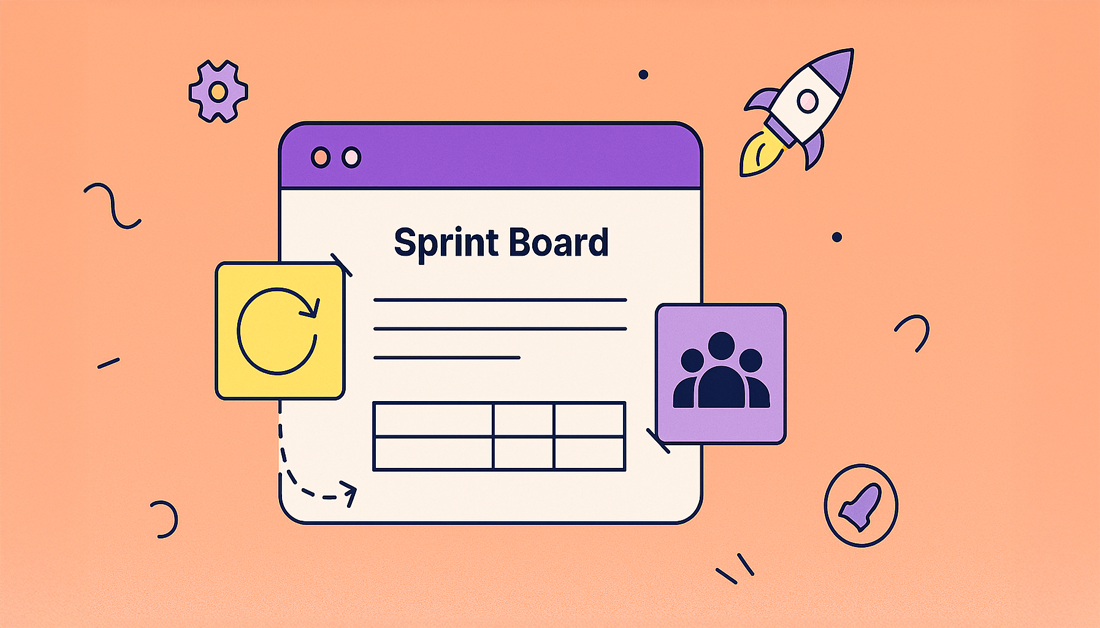Jumping into agile project development isn’t just about adopting the latest buzzword—it’s a massive shift in how high-performing teams actually build and ship valuable products. At its heart, it’s an iterative way of working where projects come to life through the close collaboration of self-organizing teams and the very customers they’re building for.
Why Agile Project Development Matters Now

In a world where market demands can shift practically overnight, the old-school, rigid project management styles just don’t cut it anymore. I’ve seen it time and again: the classic “waterfall” model, where every single phase is planned out months or even years in advance, simply leaves no room to adapt. A project meticulously planned last year can easily become obsolete before it ever sees the light of day.
This is exactly where agile project development completely changes the game.
Instead of fighting change, agile teams learn to expect it and even welcome it. The central idea is to chop up huge, overwhelming projects into small, digestible chunks we call iterations or sprints. This rhythm allows teams to ship working software frequently, get their hands on real-world feedback, and pivot when they need to.
It’s a mindset shift, really. It’s about focusing on real outcomes instead of blindly sticking to an initial plan. This approach gives teams the power to react to what they learn on the journey, making sure the final product is something customers genuinely need—not just a feature list that’s been gathering dust for a year.
The Business Case For Agility
The move to agile isn’t just something developers are pushing for; it’s being driven by hard business results. Organizations are jumping on board to get a serious leg up on the competition. A huge motivator is shortening the time-to-market. When you can deliver value in small, frequent pieces, you can start generating revenue, testing your assumptions, and building a user base much faster.
On top of that, this cycle has a built-in quality control mechanism. With constant testing and feedback loops, bugs get squashed early on before they can spiral into massive, expensive headaches later. It creates a culture where the product genuinely gets better with every single sprint.
The proof is in the numbers. The 17th Annual State of Agile Report revealed that a staggering 71% of organizations use Agile in their development lifecycle. Why? 61% do it to enhance their development processes, and 52% are focused on getting to market faster.
Understanding The Core Principles
To really get what agile is about, you have to look past the specific frameworks like Scrum or Kanban and get down to the four core values of the Agile Manifesto. These values are the “why” behind any agile practice.
We’ve broken down these foundational principles to show how they translate into real-world benefits for today’s development teams.
Core Agile Principles and Their Practical Impact
| Agile Principle | Practical Application | Business Impact |
|---|---|---|
| Individuals and interactions over processes and tools | Empowering teams to collaborate directly and solve problems, rather than getting boxed in by rigid procedures. | Leads to faster problem-solving, more innovation, and a team that’s genuinely engaged and motivated. |
| Working software over comprehensive documentation | Prioritizing the delivery of functional product increments that users can actually interact with. | Gets value into customers’ hands sooner, cuts down on wasted effort writing docs that go stale, and brings in early feedback. |
| Customer collaboration over contract negotiation | Maintaining a true partnership with the customer to build and refine the product together. | Results in a final product that hits the mark, higher customer satisfaction, and less friction when scope inevitably changes. |
| Responding to change over following a plan | Welcoming new requirements—even late in the game—as opportunities to build a better, more relevant product. | Increases market relevance, lowers the risk of building the wrong thing, and creates a more resilient, adaptive organization. |
Getting these principles to stick is the first step toward building a team that can roll with the punches. But let’s be honest—this kind of transformation isn’t always a walk in the park. Many organizations bump up against the cultural changes required, leading to some common stumbles.
To get ahead of these challenges, you might want to check out our deep dive on why agile transformations fail and how to prevent it. By understanding both the upsides and the potential hurdles from the start, you can set your team up for success.
Launching Your First Sprint with NASA
This is where the rubber meets the road. Moving from agile theory to actually running a sprint is the moment everything starts to click. Your first sprint is critical—it establishes the rhythm, habits, and expectations your team will carry through the entire project. This isn’t about abstract concepts anymore; it’s about turning agile project development into daily, tangible actions. A tool like NASA – Not Another Standup App is your best friend in getting this right from day one.
The first thing you’ll do is set up your foundation inside NASA. Go ahead and create a new project. Give it a name that’s instantly recognizable and clearly tied to the initiative. “Q3 Mobile App Revamp” works. “New Project” doesn’t. This simple step carves out a dedicated home for everything—backlog items, sprint goals, meeting notes, you name it.
Project created? Great. Now, bring in your crew. Use NASA’s interface to invite everyone to the project. Don’t skip the next part: assign their roles immediately. Designating the Scrum Master and Product Owner right away creates clear lines of accountability and prevents a ton of confusion down the line. It empowers people to own their responsibilities from the get-go.
Building Your Initial Product Backlog
With your team assembled in their new digital workspace, it’s time to build out the product backlog. This isn’t a brain dump of every feature you might want over the next year. Not at all. Your initial focus should be on capturing the high-level epics and user stories that deliver the most immediate value.
A solid user story always follows a simple, powerful format: “As a [type of user], I want [some goal] so that [some reason].” This structure is non-negotiable because it forces everyone to think from the user’s perspective.
For instance, a developer might see a task as “Add login button.” That’s the what, but it misses the why. A well-written user story provides that crucial context:
- As a returning customer, I want to log into my account quickly so that I can access my order history without re-entering all my information.
See the difference? That clarity is everything. It gives the development team the context they need to make smarter technical and design choices. Before you even think about starting Sprint 1, I always recommend having at least two sprints’ worth of well-defined stories in your backlog.
Crafting a Realistic Sprint Goal
Before you pull a single item into your first sprint, you need a sprint goal. This is a short, one-or-two-sentence statement that defines the purpose of the sprint. It’s what transforms a random list of tasks into a cohesive mission.
A strong sprint goal is the team’s “true north.” Without it, a sprint is just a collection of disconnected tasks. With it, you have a focused package of work that delivers a specific, measurable outcome. This focus is what keeps sprints from descending into chaos.
A weak goal sounds like, “Complete five user stories.” A much stronger, more inspiring goal is: “Enable new users to successfully sign up, create a profile, and log in to the platform.” This goal is about the outcome, giving the team a clear finish line to cross together.

This iterative cycle—refining the backlog, executing the plan, and reviewing the outcome—is the fundamental engine that drives real progress in any sprint.
Running Your First Sprint Planning Meeting
With a healthy backlog and a sharp sprint goal, you’re ready for your first Sprint Planning meeting. This is easily one of the most important ceremonies in Scrum. Use the agenda features inside NASA to keep this meeting structured, ensuring every voice is heard and you walk out with a solid plan.
Here’s a practical way to run that first session:
- Kick off with the Sprint Goal: The Product Owner starts by clearly stating the sprint goal. This gets everyone aligned on the “why” before you get lost in the “what.”
- Talk Through the Top Backlog Items: The team discusses the highest-priority user stories. This isn’t a one-way street; it’s a collaborative Q&A where developers get the clarity they need to estimate accurately.
- The Team Pulls in the Work: Based on the goal, the development team selects the user stories they are confident they can complete within the sprint. It’s a “pull” system—the team determines its own capacity, it’s not “pushed” on them.
- Break Down Stories into Tasks: Once stories are in the Sprint Backlog, the team breaks them into smaller, concrete tasks (e.g., “Design UI mockups,” “Set up database schema,” “Write API endpoint”).
The result of this meeting is your Sprint Backlog—the team’s collective plan for the iteration. This kind of collaborative planning is the heart and soul of the agile mindset, creating a powerful sense of shared ownership. For a deeper dive on mastering this and other ceremonies, check out this essential guide to Scrum meetings.
Getting your first sprint off the ground successfully is all about creating structure, clarity, and a shared commitment to a focused goal.
How to Run Agile Ceremonies That Actually Work

Agile ceremonies are the heartbeat of any sprint. When they’re good, they energize the team, create clarity, and push work forward. When they’re bad… well, they become those soul-crushing meetings everyone dreads. Truly effective agile project development comes down to making these gatherings genuine collaborative sessions, not just status reports.
The secret is structure without rigidity. Every ceremony, from the daily standup to the retrospective, has a unique job to do. The moment we lose sight of that purpose, they start to feel like a waste of time. A tool like NASA can install the guardrails you need to keep these meetings sharp, focused, and valuable.
Reinventing the Daily Standup
The daily standup, or daily scrum, is easily the most misunderstood agile ceremony. It was never meant to be a status update for a manager. It’s a quick, 15-minute sync for the development team to map out their day and call out anything blocking their path.
Let’s be honest, the classic “What I did yesterday, what I’ll do today, what’s in my way” can get stale. Fast. A much better way to run it is by focusing the conversation on the sprint goal. Try walking the board from right to left, talking about the work that’s closest to being done first.
This simple shift changes the entire dynamic from an “I” mindset to a “we” mindset. It stops being about individual performance and becomes about how we, as a team, can get work across the finish line. NASA’s turn-based sharing is perfect for this, making sure everyone gets a chance to speak without letting one person hijack the meeting.
A standup should feel like a team huddle, not an interrogation. The goal is to identify and swarm problems, not just report on them. If the discussion shifts into deep problem-solving, take it offline with only the necessary people. Respect the 15-minute timebox.
Of course, none of this works without a foundation of trust. To make your agile ceremonies truly effective, you have to foster transparent and clear communication within the team. Strong facilitation and an open environment are non-negotiable. If you’re looking to build this, exploring tips on effective workplace communication can give you some great strategies to improve team dynamics.
Making Retrospectives Genuinely Useful
The retrospective is arguably the most powerful ceremony for continuous improvement. It’s the team’s dedicated space to look back on the last sprint and find real ways to get better. And yet, so many retros turn into complaint sessions with zero follow-through.
To stop that from happening, you need a skilled facilitator. The Scrum Master’s job here is to create a psychologically safe space where team members feel comfortable being brutally honest without fearing blame. The focus is always on the process and the teamwork, not on pointing fingers.
Varying the format is also key to keeping people engaged. Don’t just ask “What went well, what didn’t?” every single time. Spice it up with different techniques to spark new ideas:
- Start, Stop, Continue: What should we start doing? What should we stop doing? What should we continue doing? It’s a simple but incredibly powerful framework for creating actionable ideas.
- The 4 Ls (Liked, Learned, Lacked, Longed For): This format gets at a wider range of feedback, touching on both the emotional and practical sides of the sprint.
- Sailboat/Speedboat: This metaphor helps the team visualize what’s holding them back (anchors) and what’s pushing them forward (wind).
The most important part of any retrospective is what comes out of it. Your goal should be to leave with one or two specific, actionable improvement items that you can tackle in the very next sprint. Assign an owner and add it right to your next Sprint Backlog. This creates accountability and a cycle of real, tangible improvement.
A Practical Agenda for Sprint Planning
Sprint Planning sets the entire tone for the iteration. A poorly planned sprint is pretty much doomed from the start. This meeting is all about answering two big questions: what can we deliver, and how are we going to get it done?
Here’s a practical agenda you can adapt and manage within NASA to keep the meeting from going off the rails:
| Phase | Duration (for a 2-week sprint) | Key Activities |
|---|---|---|
| The “What” | 1 Hour | The Product Owner presents the sprint goal and walks through the highest-priority items from the Product Backlog. The team digs in with clarifying questions to make sure they understand the requirements inside and out. |
| The “How” | 1 Hour | The Development Team decides which items they can realistically forecast for the sprint. Then, they break those user stories down into the smaller, more granular tasks needed to get them to “Done.” |
| Final Check | 30 Minutes | The entire team reviews the new Sprint Backlog and confirms their commitment to the sprint goal. Everyone should walk away feeling confident and aligned on the plan. |
Time-boxing is your best friend here; it’s the ultimate defense against endless debate. A well-run planning session means the team leaves with a clear, realistic plan they built together. That shared ownership is a cornerstone of successful agile project development.
Navigating the Hurdles of Agile Adoption
Making the switch to agile project development sounds like a simple change in process, but let’s be honest—it’s rarely that straightforward. I’ve seen time and again that the real roadblocks aren’t about learning new ceremonies or using different tools. The toughest challenges are buried deep in a company’s culture. It’s the unspoken resistance to change and the ingrained habits that can completely derail an agile transformation.
So many teams go through the motions. They run the daily standups, they plan the sprints, and they hold the retrospectives. But they’re just “doing Agile” without ever truly “being Agile.” The mindset is still stuck in a traditional, top-down world, which misses the entire point.
Real agility is about embracing uncertainty and trusting your team to deliver. It’s a massive cultural shift from command-and-control to collaboration.
Overcoming Cultural Resistance
The first and biggest wall you’ll hit is almost always cultural resistance. People are creatures of habit, and they get nervous when their routines and established power structures are disrupted. Managers who live and die by their detailed Gantt charts can feel like they’re losing control when a team starts self-organizing around a sprint goal.
To get past this, leaders have to become the biggest champions for the change. It all starts with building an environment of psychological safety, where everyone on the team feels secure enough to speak up, take calculated risks, and even fail without pointing fingers. When people are scared to be honest about a blocker or admit they misjudged a story point, the whole system grinds to a halt.
Creating this safe space takes deliberate effort:
- Lead with vulnerability. When a leader openly says, “I was wrong” or “I’m not sure,” it gives the team permission to do the same.
- Encourage healthy debate. You need to create spaces where different opinions can be aired out respectfully. The aim isn’t to agree on everything, but to make sure every voice is heard.
- Celebrate the lessons from failure. Frame failed experiments as what they are: valuable learning opportunities that push the project forward.
When teams feel safe, they stop just reporting problems and start solving them together. This shift from passive reporting to active problem-solving is the first major sign that your agile culture is taking root. A team that openly discusses its challenges is a team that’s poised for genuine improvement.
Demonstrating Value to Skeptical Stakeholders
Getting buy-in from leadership often means you have to speak their language: results. It’s not enough to talk about the beautiful principles of agile project development; you need to show them the tangible benefits.
Start tracking and showcasing metrics that actually matter to the business. Don’t just report on velocity. Show them how shorter cycle times are getting valuable features to customers faster. Use burndown charts to make sprint progress visible and transparent. When a stakeholder can see a real, working piece of the product every couple of weeks, the value becomes impossible to ignore.
One of the most interesting challenges is the gap between simply adopting agile practices and genuinely building an agile culture. Global data shows some fascinating regional splits here. For instance, Africa reports a strong Agile culture score of 79%, while North America is way behind at just 32%. And yet, for 85% of North American teams, Agile is the default way of working. This proves that widespread adoption doesn’t automatically create a strong cultural foundation. You can dig into these findings on agile culture from Parabol.
At the end of the day, getting over these hurdles takes patience and persistence. It’s a journey of continuous improvement—not just for the product, but for the team’s culture and processes. This is where ceremonies like the retrospective are so incredibly important. For some great ideas on how to get the most from this meeting, you might want to learn more about mastering the retrospective in your sprints. Every sprint is a new opportunity to inspect, adapt, and build a more resilient and truly agile team.
Advanced Techniques for Agile Mastery

So, your team has hit its stride. Sprints feel natural, and the core ceremonies are second nature. This is a great place to be, but it’s not the end of the road. Moving from just doing agile to truly mastering it means fine-tuning your approach, getting smart with data, and keeping the team laser-focused on what matters most: customer value.
Let’s talk about the Product Backlog first. For many teams, it’s just a long to-do list. A truly masterful team, however, treats it as a dynamic, strategic weapon. This requires a dedicated practice we call backlog refinement (or grooming). This isn’t just about throwing new user stories onto the pile. It’s a constant process of re-prioritizing, slicing up bigger items, and having the courage to delete work that no longer serves the product vision.
I’ve found the sweet spot is dedicating 5-10% of every sprint to this. When you do, the team always has a healthy pool of work that’s well-defined and ready to go. This makes sprint planning sessions incredibly smooth. A mature team should never walk into planning and see a story for the very first time. If you want to dive deeper into this crucial part of the process, check out this ultimate guide to sprint planning.
Using Metrics That Empower, Not Punish
Data can be an incredible ally in agile, but it can also be misused. Metrics like velocity and cycle time are powerful tools for improvement, but in the wrong hands, they become weapons for micromanagement. The key is how you use them. Mature teams know these numbers are for their benefit—to help them forecast and improve, not for a manager to judge their performance.
- Velocity measures how much work your team wraps up in a sprint. It should absolutely never be used to compare Team A against Team B. It’s a local weather forecast, unique to one team’s context. Its real value is in helping that specific team get better at predicting what they can realistically pull into the next sprint.
- Cycle time is different. It tracks how long it takes for a task to go from “in progress” to “done.” This is a fantastic metric for sniffing out bottlenecks. If your cycle time is creeping up, it’s a big red flag that something in your workflow is causing a traffic jam. Dig into your NASA reports to see where work is getting stuck and make that a core topic for your next retrospective.
A key sign of agile mastery is when a team uses its metrics to ask, “How can we get better?” instead of a manager using them to ask, “Why aren’t you faster?” The focus must always be on empowerment and continuous improvement.
Scaling Agile Beyond a Single Team
As your organization grows, you’ll eventually hit the challenge of getting multiple teams to work in concert on the same product. This is where you might hear about frameworks like SAFe or LeSS, but you can apply the core principles without adopting a whole new system.
It all boils down to alignment. When you have several teams sprinting at once, you need a way to make sure everyone is rowing in the same direction. A common practice is the “scrum of scrums,” where a representative from each team meets regularly to sync up on progress, untangle dependencies, and tackle cross-team roadblocks.
This also means thinking beyond the two-week sprint horizon. For larger initiatives, you need a way to connect your sprints to bigger, quarterly objectives. For teams looking to get better at this, learning about setting impactful quarterly goals provides a fantastic structure for aligning multiple teams toward a shared purpose.
Mastering Scope Creep and Forecasting
Let’s be real: scope creep happens. In agile, we don’t run from change; we manage it. When a stakeholder pops up with a “brilliant new idea” mid-sprint, the answer isn’t a hard “no.” A seasoned Product Owner will handle it with grace.
The pro response sounds something like this: “That’s a fantastic idea! Let’s get it into the backlog right away. If we absolutely need it in this sprint, which of our current sprint goals should we swap out to make room for it?”
This simple conversational pivot is a game-changer. It respects the stakeholder’s input while making the trade-offs crystal clear. It protects the team’s focus and turns a potential conflict into a collaborative negotiation.
This ties directly into better forecasting. An advanced team stops making promises based on gut feelings and starts using real data. By tracking your average velocity, you can build a reliable release forecast that gives stakeholders a realistic window for when those bigger features will actually land. You move from wishful thinking to data-driven confidence.
Frequently Asked Questions About Agile
As teams start exploring a shift to agile, a flood of questions usually follows. That’s perfectly natural when you’re fundamentally changing how you work. We’ve pulled together some of the most common questions we hear from teams and leaders, answering them with practical, real-world advice.
How Is Agile Different From What We Do Now?
The biggest shift is in the overall approach. Traditional methods, like Waterfall, are all about extensive upfront planning. You try to define everything at the very beginning and then execute that rigid plan over many months.
Agile project development, on the other hand, is all about iteration. Instead of aiming for one massive launch, you deliver work in small, frequent cycles known as sprints. This rhythm lets you gather feedback early and often, adapt to changes, and make sure you’re always building something your customers actually want—not just blindly following an outdated plan.
Can Agile Work for Non-Software Teams?
Absolutely. While agile got its start in the software world, its core principles—collaboration, iterative progress, and customer feedback—are valuable everywhere.
- Marketing teams use it to run campaigns in sprints, constantly testing messaging and creative assets.
- HR departments apply it to refine processes like employee onboarding.
- Product teams use it for everything from prototyping new ideas to developing hardware.
The real focus is on delivering value incrementally and being able to pivot based on what you learn along the way. That’s a huge benefit for any complex project where you can’t know everything upfront.
Agile isn’t a rigid methodology; it’s a mindset. Its values—prioritizing people over processes, working results over documentation, customer collaboration, and responding to change—can be applied to almost any kind of knowledge work. It’s really about how you approach solving problems.
How Long Should Our Sprints Be?
There’s no magic number here, but the most common sprint length is two weeks. For many teams, this is the sweet spot. It’s long enough to complete a meaningful chunk of work but short enough to keep a sense of urgency and allow for quick feedback loops.
Some teams thrive on one-week sprints for super fast-paced projects, while others might go with three or four weeks if their work is more complex. The real key is consistency. Once you pick a sprint length, stick with it for a while to let your team find its rhythm.
What’s the Difference Between Agile and Scrum?
This is a classic point of confusion, and it’s a great question. The easiest way to think about it is like this:
- Agile is the overarching philosophy or mindset, guided by the values in the Agile Manifesto. It’s the “why.”
- Scrum is a specific framework—a set of defined roles, events, and rules—that helps you put the agile philosophy into practice. It’s a popular way of doing the “how.”
So, while Scrum is agile, agile isn’t just Scrum. Other frameworks like Kanban are also agile; they just offer a different approach to reaching the same goals.
Do We Still Need to Estimate Work?
Yes, but agile estimation is a different beast. Instead of trying to guess exact hours, many agile teams use story points. These are relative units that help gauge a task’s effort, complexity, and uncertainty all at once. This approach helps teams forecast what they can realistically get done in a sprint without getting bogged down in the false precision of time-tracking.
To get a better handle on this, you can explore various agile estimation techniques and their benefits to see what might click for your team.
Ready to run meetings that actually drive results? With resolution’s NASA – Not Another Standup App, you can facilitate focused, effective agile ceremonies right inside Jira. Learn how NASA can bring clarity and accountability to your team’s workflow.
